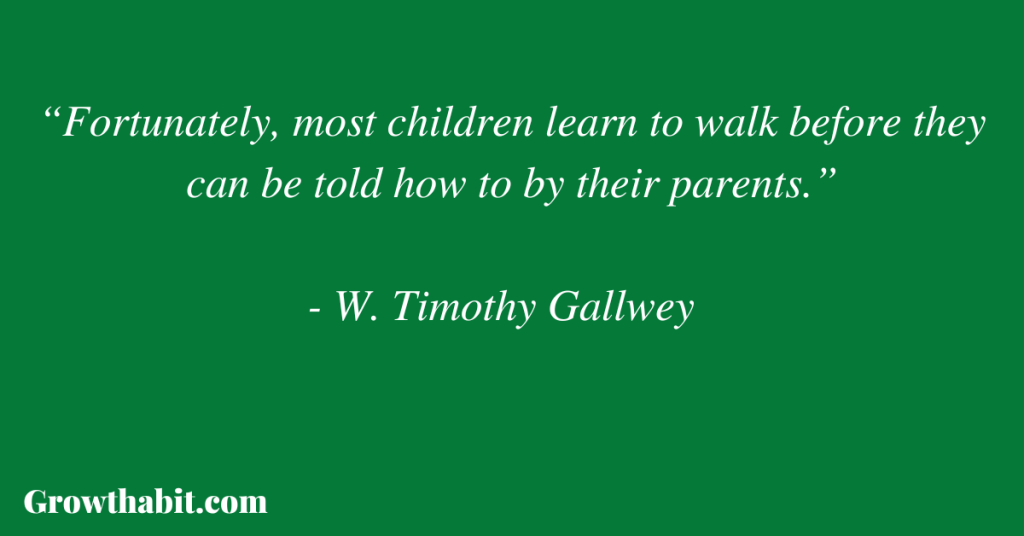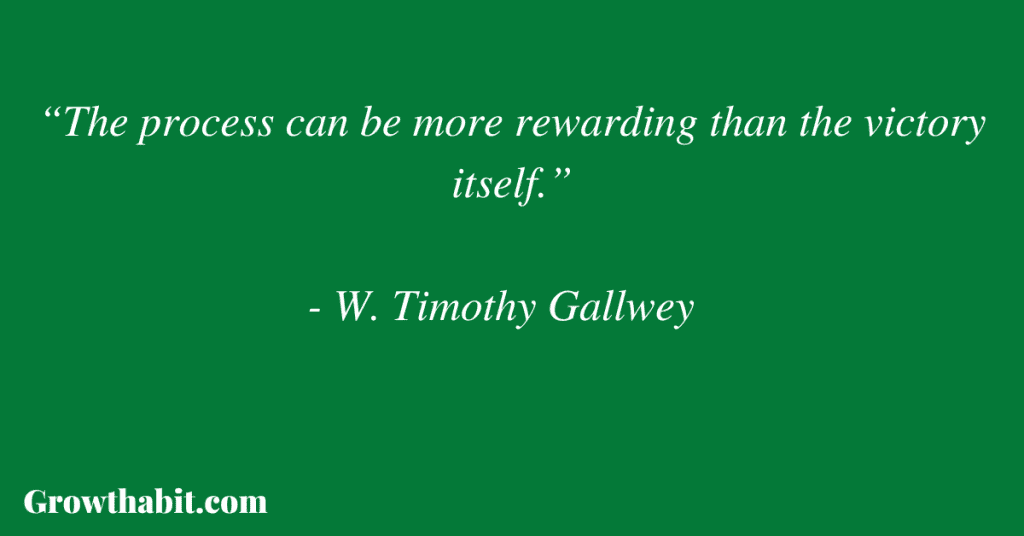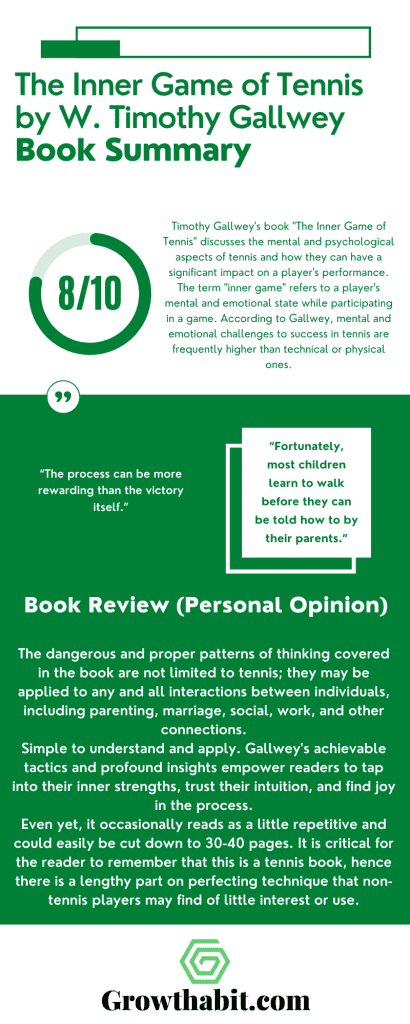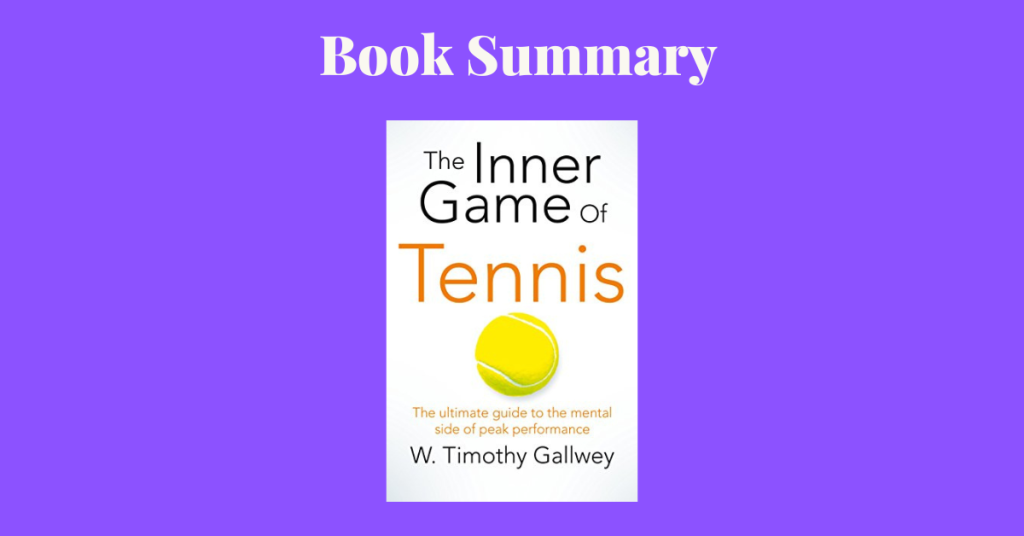Timothy Gallwey’s book “The Inner Game of Tennis” discusses the mental and psychological aspects of tennis and how they can have a significant impact on a player’s performance.
The term “inner game” refers to a player’s mental and emotional state while participating in a game. According to Gallwey, mental and emotional challenges to success in tennis are frequently higher than technical or physical ones.
Each game comprises of two additional games. The outside game, in which the player competes against an opponent; and the inner game, which occurs in the player’s mind.
The Inner Game is a constant battle with distractions, worry, self-doubt, and self-loathing. Awareness and mindfulness are the most important skills for a player to master in order to succeed in the Inner Game.
Through these abilities, players can learn to trust their natural abilities, focus on the present moment, and let go of self-doubt and distractions.
Book Title— The Inner Game of Tennis: The Classic Guide to the Mental Side of Peak Performance
Author— W. Timothy Gallwey
Date of Reading— May 2023
Rating— 8/10
What Is Being Said in Detail
INTRODUCTION
The beginning of the introduction says that there is psychology in sports. In the heat of competition, athletes can freeze up and fail. Every game has two parts: the inside game and the outside game.
This book says that if you want to learn any game and get the most out of it, you need to work on your inner game, which is often overlooked.
Athletes who focus on improving their “inner game” learn the value of unforced focus, develop genuine self-assurance, and realize that the key to success is to let up on the gas pedal. (This will be made clear later).
The inner gamer can overcome obstacles and release the drive to succeed that is not weakened by setbacks.
The Inner Game also discusses a common method of learning, one that most of us are familiar with.
It says that the book is about using tennis to help people reach their full potential.
CHAPTER 1. Reflections on the mental side of tennis
When it comes to teaching tennis, Gallwey observes that more instructions tend to get in the way of a student’s ability to learn.
There is also the phenomena known as “playing in the zone,” which refers to performing much above one’s skill level without having complete awareness. You can’t explain the feeling, but when you’re in that zone, you can do things you didn’t think were possible.
CHAPTER 2. The discovery of the two selves
The most important thing that determines a player’s ability to put his technique information into effective action is how Self 1 and Self 2 relate to each other.
In other words, the key to getting better at tennis, or at anything else, is to improve the relationship between Self 1 (your conscious mind) and Self 2 (your natural skills).
Joan was starting to notice that “trying hard,” which came from Self 1, was different from “effort,” which came from Self 2.
Self 1 had his complete attention focused on the seams of the ball throughout the most recent set of balls. So, Self 2 could do its own thing without any problems, and it was pretty good at it. Self 1 was starting to notice that Self 2 was good at things; she was putting the pieces together.
The goal is to get Self 1 off track. This can be accomplished by the following three methods: having the most straightforward possible picture of desired results; trusting self 2; and seeing without judgment.
CHAPTER 3. Quieting Self 1
During times of peak success, Self 1 is not there at all. People will say things like, “effortless,” and “he was in the moment” since it does not involve any thought, and everything just happens.
Clearly, “getting it together” entails silencing Self 1 so that one’s thoughts become at rest. When you are completely present in the moment and at one with the situation and your performance, your mind will be at rest.
The first step is to watch without judging. You look on from a distance. There are no good or bad beliefs, and you can’t judge yourself or feel happy.
Once a decision has been made, Self 1 is called on to do more research. This will not work since it will prevent progress if it is allowed to continue.
If mistakes happen, don’t add anything to them; just see them as they are. Like a rose that is trying to grow. When it first starts to grow, we don’t say it’s too small. When it starts to grow, we don’t say that it’s not fully grown yet. In the same way, making mistakes is a part of learning tennis.
The first step is to look at each move for what it is. This isn’t a small thing, and most people don’t do it. Gallwey tells the story of a businessman who can’t fix his backswing no matter how many lessons he takes.
Gallwey shows the man his backswing in the mirror of a window. For the first time, the man really sees what it means to bring his racket down and is able to fix it.
The next step in knowing what to do is to always know where the ball is and where your stick is. Pay close attention and always know where your racket is.
The same kind of learning process that toddlers use to learn to walk can be triggered by simply improving one’s feeling of these two elements without making any value judgments.
Gallwey observes, as an aside, that positive thought does not serve any purpose. Praise is the opposite of criticism, It gets Self 1 involved. Both are used to change how people act. Instead, the goal is what really matters.
CHAPTER 4. Trusting Self 2
Self 2 is the physical body, which is made up of the brain, memory bank (both conscious and unconscious memories), and nerve system, is a very complex and capable set of possibilities.
When Self 1 stops criticizing Self 2, that is a clear indication to Self 2 that Self 1 trusts it. After trust has been established, the second component necessary for high-performance, which is self-confidence, can then be developed in a risk-free environment.
The connection between Self 1 and Self 2 is like the one between a parent and a child. Some parents find it hard to let their kids do something when they think they know how it should be done better.
A loving and dependable parent, however, will provide their child the freedom to make errors and learn from them.

When the stakes are high, Self 1 may try to take charge of the situation and the result is a tightening of the grip on the shot. Most of the time, the effects are frustrating.
Most kids learn to walk on their own before their parents can show them how. But kids not only master the skill of walking, but they also develop faith in their own natural tendency for learning.
The Inner Game involves three basic skills: letting go of opinions, learning how to create images, and “letting it happen.”
CHAPTER 5. Discovering Technique
Allowing ourselves to become overly reliant on instructions can substantially damage our access to our natural learning processes and our abilities to perform.
Instead, if we rely on Self 2’s instincts when we hit the ball, we strengthen the easiest neural pathway that leads to the best shot.
Too many verbal orders, whether they come from outside or inside, make it hard to make a good shot.
Getting expert advice is the best method to jumpstart this discovery. Master tips are the ones that, if you use them well, make most moves fall into place on their own. It’s like getting rid of fifty problems with one stone.
Master tips are not really directions. They are hints that help you find your way along the road to discovery.
CHAPTER 6. Changing Habits
Habits are hard to break. You must change it out. To break a habit, you just have to learn how to do that thing better.
Here is how you can learn anything. Why is it easy for a child to learn a new language? Because the child’s Self 1 doesn’t get in the way of how they learn.
Here, “learning” doesn’t mean gathering facts; it means getting the skills to do something that gets you a result.
Changing a habit isn’t easy. It will be much easier to break this habit if you know why you do it in the first place. This will help you find another method that gives you the same result.
According to the groove theory of habits, the more often you do something, the more likely it is that you will do it in the exact same way that you did it before.
The movement, called a groove, gets stronger in the brain the more it is done.
This is why it’s hard to break bad habits.
In fact, we can’t break them no matter how hard we try. Because of this, replacing old habits with new ones, or “New grooves,” is preferable to just breaking them.
Here is a short overview of how we have been taught to learn in the past and how the Inner Game of learning is different.
Step 1: Watch without judging. Look at the situation you want to change and how you are doing it now. Get a feel for it, make sure you’ve repeated it multiple times, and comprehend it.
Step 2: See yourself getting what you want. One way to do this could be to watch someone who moves in a way that inspires you. Don’t overthink it; just take in what you see and try to feel what he feels.
Step 3. Trust Self 2. Try it again, but don’t try to control it this time.
Step 4: Watch the changes and results without judging them. Watch the process unfold without trying to change it. The more you are able to surrender to the natural process at work, the less likely you will be to revert to your habitual patterns of working too hard, making judgments, and over-analyzing.
CHAPTER 7. Concentration: Learning to Focus
It’s not easy to tell Self 1 to back off and let Self 2 do the work. And letting go of Self 1 is a big step, but it’s not enough to become an expert.
We can’t just put our minds to rest. We need to find a place for it. You can’t just “let go” of your mind; you have to park it.
When the mind isn’t on one thing, it goes in all different ways and can’t be still. When the mind is on something, it can be quiet. Putting the mind in park is done by focusing.
When you concentrate, you pay attention to one thing and only that thing. It helps us keep our minds on the here and now.
Because of this, the mind becomes calm. To start training for attention, all you need is something to focus on.
The best way to get more focused is to pay attention to something small. Love can help us stay focused for longer.
Bhakti yoga, also called “the yoga of love,” says that loving the object of attention helps you concentrate on it until you become one with it.
Learn to love what you need to pay attention to.
Our awareness (the mind inside us) lets us know what’s going on in the world.
It is consciousness that lets us see, hear, feel, and think, which are all parts of what we call “experience.”
You can’t have an event outside of your mind. The five senses and the mind make consciousness possible. Your mind picks up a lot of things (smells, sounds, pictures, etc.), but you only notice a few of them at a time because you naturally focus on a few.
Meditation is the best way to improve your ability to pay attention.
CHAPTER 8. Games People Play on the Court
In this chapter it is discussed how we live in a world that values success and where people are often judged by how good they are at different things. Even before we got our first report card with a good or bad grade, we were liked or ignored based on how well we did our first actions.
To get out of this trap, you need to know for sure that a person’s worth can’t be judged by how well they perform or by any other meaningless standard.
You are valuable just by virtue of existing; your worth is not derived from the things you achieve but rather from who you are.
The score is not indicative of who you are; all it shows is how well you performed.
CHAPTER 9. The Meaning of Competition
In the Western world, competition is a touchy subject. Some argue that it pits people against one another, while others argue that it unleashes performance, resulting in growth and wealth.
It’s true that a lot of people try to show who’s in charge. But these reasons come from a place of fear and self-doubt.

This is where a player’s worst qualities can be seen. When a player loses, they don’t get mad or act badly because they know their self-worth doesn’t rest on how well they do.
Sadly, a lot of people think they are as good as they act. When they lose in a battle, it hurts their sense of self-worth. The real point of competition is much deeper than that.
Like the author, most people start out in competition with an unquenchable desire to win and play, to be the best. The author eventually went off in a different direction. He learned yoga and gave up trying to win in favor of trying to play well.
But because he didn’t want to win as much as he used to, he didn’t fight as much. He started to wonder if he could want to win without wanting to be better.
One day, the author went to play very angry because a girl had canceled a date with him for the third time. He played very well. He understood that his anger had caused him to play “out of his mind.” He had played just for fun, not caring if he won or lost, but he was still determined to win.
While thinking about surfing, the author understood what it meant to win.
Surfers don’t really fight against each other; they just ride waves, but not just any waves. They want to see how far they can go on the big ones.
Only when he faces the biggest task will the surfer know how far he can go. Larger waves present greater opportunities for surfers to realize their full potential. The challenge presented by the wave helps the surfer grow and go beyond his or her own limitations.
CHAPTER 10. The Inner Game Off The Court
Learning to accept obstacles in competition automatically makes it easier to find advantages in all the problems you face in life. The author then emphasizes the significance of inner stability.
You can’t find inner stability by putting your head in the sand when you see danger. Instead, you need to be able to see what’s really going on and act in the right way.
Instability, on the other hand, is a state in which Self 1 is more likely to be thrown off balance by an event or situation.
The word “attachment” sums up what causes most stress.
Self 1 gets so used to the things, situations, people, and ideas in its life that it feels threatened when something changes or seems like it might change.
To be free of stress, you don’t have to give up anything. Instead, you need to be able to let go of anything when you need to and know that you’ll be fine. It comes from being more independent—not necessarily more alone, but more depending on one’s own inner resources for stability.
Freedom from stress depends on how much we listen to our real selves, giving Self 2 a chance to be who it is and enjoy the process every time it can. From what I can tell, this is something you learn over time.
Focus is the simple theme of “The Inner Game.” Pay attention to what is going on right now. Focus means that I don’t think too much about the past, whether it’s my mistakes or my successes.
It also means that I don’t get so caught up in the future, whether it’s my fears or my hopes, that I can’t pay attention to the moment. It doesn’t mean you shouldn’t think, but that you should control your own thoughts.
Most Important Keywords, Sentences, Quotes
INTRODUCTION
“When we plant a rose seed in the earth, we notice that it is small, but we do not criticize it as “rootless and stemless.” We treat it as a seed, giving it the water and nourishment required of a seed.”
“Fear, which is probably the biggest obstacle to any learning process, is a repressive force. It exists in the mind, and almost always it is based on something that might happen in the future, rather than what is happening now.”
CHAPTER 1. Reflections on the mental side of tennis
“For the teacher or coach, the question has to be how to give instructions in such a way as to help the natural learning process of the student and not interfere with it.”
“Fortunately, most children learn to walk before they can be told how to by their parents.”
CHAPTER 2. The discovery of the two selves
“It is said that in breathing man recapitulates the rhythm of the universe. When the mind is fastened to the rhythm of breathing, it tends to become absorbed and calm.”
“Letting it happen is not making it happen. It is not trying hard.”
CHAPTER 3. Quieting Self 1
“Once one recognizes the value of having difficult obstacles to overcome, it is a simple matter to see the true benefit that can be gained from competitive sports.”
“Only by playing the role of your enemy does he become your true friend. Only by competing with you does he in fact cooperate! No one wants to stand around on the court waiting for the big wave.”
CHAPTER 4. Trusting Self 2
“Relaxation happens only when allowed, not as a result of “trying” or “making.””
“The arrow is off the string but does not fly straight to the target, nor does the target stand where it is.”
CHAPTER 5. Discovering Technique
“The backhand can be used to advantage only on a tennis court, but the skill of mastering the art of effortless concentration is invaluable in whatever you set your mind to.”
“The development of inner skills is required, but it is interesting to note that if, while learning tennis, you begin to learn how to focus your attention and how to trust in yourself, you have learned something far more valuable than how to hit a forceful backhand.”
CHAPTER 6. Changing Habits
“The player of the inner game comes to value the art of relaxed concentration above all other skills; he discovers a true basis for self-confidence; and he learns that the secret to winning any game lies in not trying too hard.”
“The process can be more rewarding than the victory itself.”
CHAPTER 7. Concentration: Learning to Focus
“The rose is a rose from the time it is a seed to the time it dies. Within it, at all times, it contains its whole potential.”
“We stand in wonder at the process taking place and give the plant the care it needs at each stage of its development.”
CHAPTER 8. Games People Play on the Court
“What is required to disengage oneself from this trap is a clear knowledge that the value of a human being cannot be measured by performance—or by any other arbitrary measurement.”
“When the mind is free of any thought or judgment, it is still and acts like a mirror. Then and only then can we know things as they are.”
CHAPTER 9. The Meaning of Competition
“When we plant a rose seed in the earth, we notice that it is small, but we do not criticize it as ”rootless and stemless.” We treat it as a seed, giving it the water and nourishment required of a seed.”

“Whether on or off the court, I know of no better way to begin to deal with anxiety than to place the mind on one’s breathing process.”
CHAPTER 10. The Inner Game Off The Court
“Winning is overcoming obstacles to reach a goal, but the value in winning is only as great as the value of the goal reached. Reaching the goal itself may not be as valuable as the experience that can come in making a supreme effort to overcome the obstacles involved.”
Book Review (Personal Opinion):
The dangerous and proper patterns of thinking covered in the book are not limited to tennis; they may be applied to any and all interactions between individuals, including parenting, marriage, social, work, and other connections.
Simple to understand and apply. Gallwey’s achievable tactics and profound insights empower readers to tap into their inner strengths, trust their intuition, and find joy in the process.
Even yet, it occasionally reads as a little repetitive and could easily be cut down to 30-40 pages. It is critical for the reader to remember that this is a tennis book, hence there is a lengthy part on perfecting technique that non-tennis players may find of little interest or use.
This Book Is For:
- Athletes who want to improve their performance
- People who seek growth and want to reach their goals
- People who want to deal with their anxiety during tough times
If You Want to Learn More
Here is a video about Tim Gallwey’s method. Inner Game of Tennis (Tim Gallwey method).
How I’ve Implemented the Ideas from The Book
As a freelancer, I am constantly juggling a multitude of tasks while working under deadlines and delivering quality work. As a result, I frequently feel overwhelmed and struggle to maintain attention.
By focusing on the present moment, I became more aware of my current tasks and was able to fully immerse myself in the work at hand. To boost my productivity and concentration, I completely immerse myself in the present moment and focus on the process rather than the outcome.
One Small Actionable Step You Can Do
Spend a few minutes each day practicing mindfulness. Paying close attention to the current moment while objectively evaluating your thoughts, feelings, and experiences is what mindfulness includes. This exercise can help with the development of self-awareness, attentiveness, and a non-reactive mindset.

